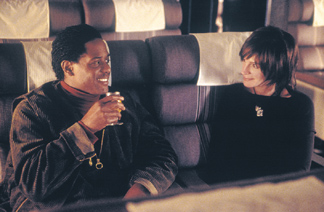Full Frontal
Film within a film within video
By Rachel Deahl

“What’s with you and J. Lo marrying these no-name losers?”
Billed by Miramax as a kind of companion piece to sex, lies and videotape, Full Frontal was touted as the glorious reunion of the wunderkind arthouse director turned Hollywood golden boy (and Oscar darling), Stephen Soderbergh. It was made by the indie film company-slash-mainstream studio that put his first effort in theaters.
In 1989, when sex, lies and videotape was released by Miramax, Soderbergh was an unknown and Miramax was far from a household name. The studio largely distributed foreign titles and groundbreaking works like Errol Morris's documentary, The Thin Blue Line (1988). And, when sex, lies and videotape exploded onto screens (so to speak), there was much to be excited about. A bold and brilliant investigation into the nature of love, deceit, sex, and our inherent need to watch, the film was undoubtedly the best of the year and easily the finest achievement of the decade.
Today, Miramax is an established Hollywood player clinging to a shrinking reputation as a daring studio, distributing equal amounts of mainstream crap alongside a roster of independent pictures and foreign titles. The gamut swings from In the Bedroom to 40 Days and 40 Nights to Baran. Soderbergh has evolved as well, from a daring innovator into a more conventional filmmaker. A cynic might cite this reunion as the joint venture of two sell-outs. If that seems a bit unfair or overzealous, the final product appropriately has the last word.
A disappointing, self-indulgent stab at Hollywood, painted as an investigation into filmmaking, Full Frontal has neither the bite nor the freshness that Soderbergh's debut demonstrated. If anything, this flashy experiment is more reminiscent of the shallow, self-righteous whining that categorized the grueling Hurlyburly than the moving theatrics that propelled sex, lies and videotape.
Shot on film and digital video, Full Frontal follows a group of Los Angeles natives throughout the course of a single day as their lives intertwine and overlap (see also: Altman; see also, The Player).
The disparate bunch (friends, relatives, lovers, coworkers) finally converges at the birthday party of Hollywood producer, Gus (David Duchovny).
Julia Roberts plays a Julia Roberts-like actress named Francesca (Notting Hill territory) who's playing "Catherine" in the film within the film; David Hyde Pierce is a nebbish, insecure Niles Crane-like magazine writer named Carl; Catherine Keener is his uber-bitchy and unhappy wife, Lee (seemingly reprising her roles from both Your Friends and Neighbors and Being John Malkovich); and Blair Underwood is Calvin, the philandering actor who stars opposite Roberts in the film within the film as Nicholas.
Structured around the movie Francesca and Calvin are making (which is, incidentally, about making a film), Full Frontal begins within the narrative of its internal film. The nameless vehicle is purportedly a trite romance about a reporter, Catherine (Roberts) who's doing a story on an up-and-coming black actor named Nicholas (Underwood).
For seemingly uncompelling reasons, Soderbergh chooses to shoot the film within the film on film stock and the "reality" section of the movie on digital video. The clash of the two mediums is more annoying than anything else and does little more than provide a logical point of differentiation between the story, and the story within the story. (He's a long way from Traffic.)
The ceaselessly talky narratives, which finally parallel one another, creak along at a sluggish pace. Aside from a selection of hilarious scenes in which Keener's HR Manager takes sadistic pleasure in firing a string of employees, Full Frontal offers up a collection of lifeless characters wandering through a vaguely reminiscent Hollywood narrative.
Mostly what Soderbergh delivers is an onslaught of mindless cameos and in-jokes about the off-screen careers of his stars. Brad Pitt appears to do a cameo in the film within the film. Terrence Stamp appears in the background of a few scenes as if he's stumbled out of a frame of The Limey and landed in Soderbergh's latest creation by accident. Julia Roberts picks up a hot young "lighting guy" at a party as if her recent real-life hubby, cameraman Daniel Moder, were given an on-screen persona. Miramax head Harvey Weinstein appears at the wrap party alongside Soderbergh. The effect is more obnoxious than funny or interesting. Robert Altman jammed more biting humor and intelligent satire into five minutes of The Player than Soderbergh gets into the entirety of Full Frontal. Let's hope there are more effective, enjoyable, and stirring ways to drive home the notion that films are built on artifice than by producing an artificial film.
HOME | THIS ISSUE | ACE ARCHIVES